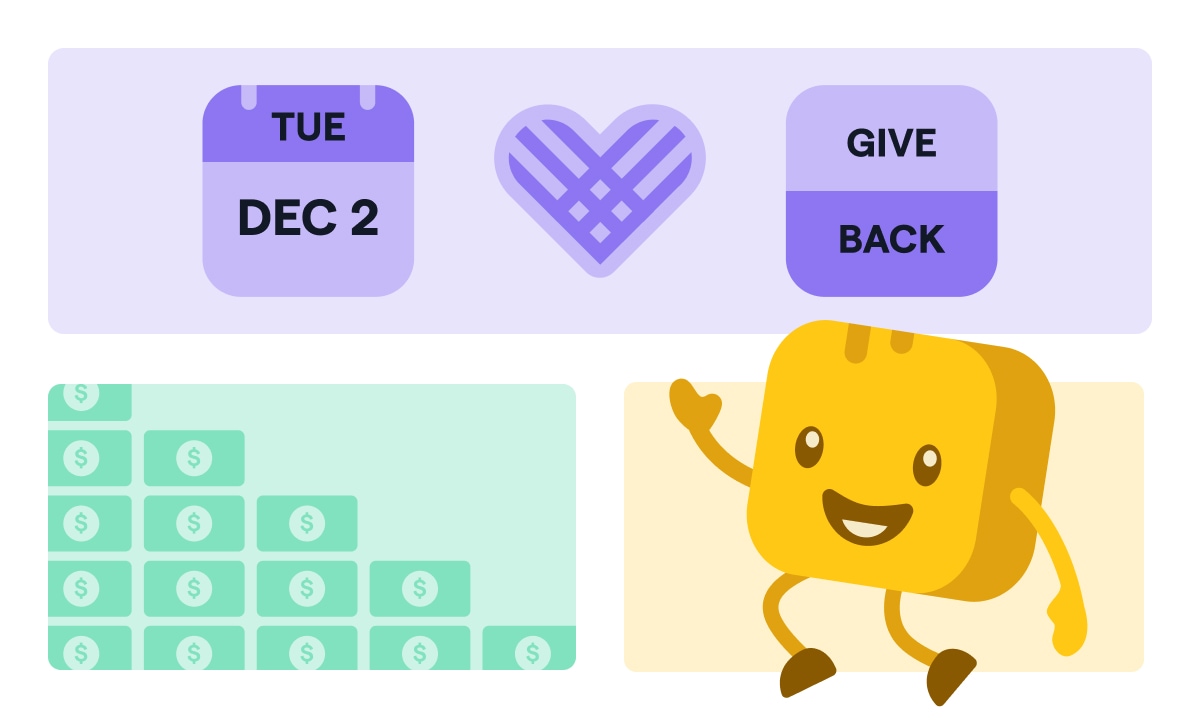Table of contents
Table of contents
For busy organizations, creating a nonprofit marketing plan can fall last on the to-do list. It takes lots of energy, time, and the right tools to really nail it. But despite the heavy lift, it’s one of the best ways to capture people's attention and turn them into lifelong supporters.
In this guide, we’ll show you how to create scroll-stopping content and hit your goals with our best tips, tricks, and a free nonprofit marketing plan template.
What is nonprofit marketing?
Nonprofit marketing is an organization’s ongoing strategic efforts to raise awareness about its mission and connect with current and potential supporters. Digital marketing for nonprofits helps an organization establish a brand identity, bring in donations, find new partners or volunteers, and start a conversation with supporters.
However, every organization’s goals for their nonprofit marketing strategy might differ. According to Cody Hays, Executive Director of Marketing Mission, some examples of marketing goals for a charity might include:
- Increasing attendees for an upcoming event 👯
- Creating a pool of potential donors through promoting email newsletter sign-ups ✉️
- Raising a specific dollar amount through online fundraising initiatives 💸
To understand marketing, it’s sometimes helpful to remember what marketing is not. So before diving further into this subject, let's first clear up a few common misconceptions.
- Marketing is not just a logo 🙅 Marketing for nonprofit organizations is the accumulation of conversations, stories, content, graphics, and even your tone of voice.
- Marketing is not conversations just about yourself 😱 Marketing involves ongoing interactions such as liking, sharing, and responding to supporters, and even re-sharing content from like-minded changemakers.
- Marketing is not just paid advertisements 🙈 Online marketing for nonprofits, in particular, requires organizations to get creative in how and where they connect with audiences—think online community forums, influencers, and podcasts.
Now that we know what marketing for nonprofits isn’t, let’s explore what it should look like.
6 nonprofit marketing truths to live by
In one of our favorite episodes of the We Are For Good podcast, Back to the Basics: Nonprofit Branding and Marketing, co-hosts Jonathan McCoy and Becky Endicott dive into how to establish a values framework for nonprofit marketing with six marketing truths:
- People matter 👪 Communicate like a human being—not like a textbook.
- Optics matter 🎨 Prioritize visually appealing content.
- Story matters ✍ Evoke emotion with real-life narratives.
- Resonance matters 💛 Return to your "why" and carry it across all content and channels.
- Authenticity matters 👯 Show up as your authentic self—it will never be sales-y.
- Your brand matters 🎉 Let your personality and values shine through in every piece of content.
So how do we translate these values into an actionable plan?
How to create a stellar nonprofit marketing plan in 5 steps
While there are plenty of ways to craft a great marketing plan for nonprofit organizations, every effective strategy includes a few basic steps.
Step 1: Research and build donor personas 👤
Reaching the right people in the right place is essential to the success of a campaign. To determine your ideal audience, analyze the information you currently have. Use your CRM system to filter, sort, and segment your supporters based on information like previous gift size, geographical location, gender, age, or activity (volunteer, event attendee, etc). Then, develop target marketing personas.
To increase customer engagement, marketers create a "buyer persona," or a fictional character that helps them understand their target audience. You can use this same strategy to increase donor engagement for your organization. Consider common traits between your current donors like demographic data and interests, such as job titles and income level, hobbies, other supported causes—even the podcasts they listen to.
Try to attach marketing personas to different segments, then tailor your communication styles to each segment. It's normal to have more than one donor persona in your audience. For example, if you're a high school cheerleading squad tackling your annual fundraiser, three different personas may look like this:
- The soccer parent 👪 A mid-40s parent with a connection to the school. This adult has a child who is enrolled in the school and involved in extracurriculars, even if it isn't cheerleading.
- The business owner 🤝 A mid-50s to 60s adult with deep ties to the local community (such as owning a local business). Their children have graduated, but they stay involved in school functions to attract new customers.
- The honor roll 🌟 A high school student or recent grad who is deeply involved in school functions. While they may not donate, it's important to attract their attention because they bring other parents and students to your annual fundraiser.
Think about expanding your audience—who would you want to target? Create (and write down!) a list of your ideal donors and their specific traits.
Step 2: Set a marketing goal and work backward 🎯
Setting clear objectives—or SMART goals (specific, measurable, achievable, relevant, and time-bound)—ensures your marketing plan ties back to your larger organizational goals.
To build SMART goal for your marketing plan, consider what you’re trying to achieve with a particular campaign goal. A few examples include:
- Increase web traffic by 1,000 visitors per month 🎯
- Double the number of event attendees from the past event 🎯
- Grow mobile donations by 25% within 30 days 🎯
Once you have a clear goal attached, you can work backward and outline your marketing activities in a campaign calendar. When will various aspects of your plan go live? Who is in charge of what parts of the plan?
Step 3: Develop core messages 💌
Before you can fully dive into your marketing campaign, you must develop a core message that’s easy to understand and connected to the mission. To create a core message, think of every reason why someone might give to or otherwise support your cause, then rank them according to priority.
Be sure to consider:
- Primary reason ⭐ What is the number one reason people support your cause? This is your core message and should be used in your social media bios, landing page headers, the SEO paragraph of your website, and other prominent places.
- Secondary reasons ✨ What might be another motivation for someone to support your cause? These are reasons that may apply to some, but not all, of your donor personas. These secondary reasons will appear within sub-pages and paragraph text on your website, email copy, social media marketing posts, or case studies.
Step 4: Finalize your call to action—and give it a home 💸
Now that you identified your campaign purpose, you can zero in on your call to action (CTA). While you may have several messages for your campaign, it’s essential to be as specific as possible about what you want your audience to do (e.g. donate!).
Too many CTAs can dilute your message and confuse supporters. Think of it like the headline of a press release. For example:
“Donate today to protect the water you love.”
Your CTA should take people to one place to create conversions. This could be a signup form, a donation landing page, or a fundraising event registration URL. Make sure this CTA is consistent across your channels.
Step 5: Share the message 📣
Once you have all the right foundations in place, its time to create some content. First, assess the right channels for your nonprofit marketing plan, depending on your audiences (developed in the persona step), and your budget.
Common channels for content marketing for nonprofits include:
- Email marketing 📨 Set up outbound email blasts and design them with your unique logo and branding.
- Social media 📱 Post events, testimonials, and eye-catching graphics on your social media channels.
- Website 🖥️ Design your website and event pages with SEO nonprofit best practices in mind for some organic reach with content marketing. You can even embed signup forms to empower prospective donors to opt-in to hearing from you!
- Direct mail 📫 Digital marketing for nonprofits isn’t the only solution. Direct mail fundraising is another great way to spread the word about your mission.
- SMS messages 💬 Outbound text blasts are perfect for grabbing the immediate attention of supporters.
- Events 🎉 Whether your event is virtual, in-person, or hybrid, remember to take advantage of connecting with supporters in real time.
💡 Pro tip: For nonprofits that are interested in multi-channel marketing—and taking advantage of a few different marketing methods—it’s important to invest in a nonprofit marketing and engagement automation platform to streamline all of your content.
Start strong with this free nonprofit marketing plan template
A nonprofit marketing plan template is a great tool for keeping your entire team (staff, volunteers, board members, etc.) on the same page.
This comprehensive document, which hosts all the information about your nonprofit marketing strategy, can be referred to at any time. In a way, it acts as a centralized information hub for your team to rely on as they make progress.
When creating your nonprofit marketing plan template, you should include:
✅ S.M.A.R.T. marketing goals: List one or several objectives that are specific, measurable, achievable, relevant, and time-bound.
✅ Restatement of mission and values: Remind your team of who you are as an organization and the vision you have for making the world better.
✅ List of key players: Include details about who will handle each part of the marketing strategy.
✅ SWOT analysis: Assess your strengths, weaknesses, opportunities, and threats.
✅ Target audience details with personas: Include information about age, giving history, and more.
✅ Competitive analysis: Consider what organizations you’d like to stand out from.
✅ Branding and messaging details: Add brand colors, fonts, and a style guide, if necessary.
✅ Channels and tactics: Identify what kind of platforms you’ll use, and why.
✅ Budget and resources assessment: Determine how much money your team can allocate to your nonprofit marketing strategy.
✅ Technology assessment: Consider what tools and nonprofit software your organization will need to meet its goals.
Best practices for setting your nonprofit marketing up for success
As you develop your marketing strategy, keep these tried-and-true tips in mind:
1. Set yourself apart ⚡
The nonprofit world is crowded. To stand out, focus on what makes you different. What can you say that no one else in your sector can say?
Sometimes, marketers worry that they will alienate a potential group of supporters by getting specific about their offerings. Instead, avoid generic jargon and to-the-masses messaging. Focus instead on stories that are specific to your organization.
2. Lean on your team 🫂
To help communicate your message wide and far, train your volunteers, staff, board members, and loyal donors as brand advocates. They can help spread the word about your mission and impact in organic ways.
3. Think outside the box 📦
Consider tactics like a guest blog series to bring in new voices and content you can repurpose across platforms like your newsletter and social media posts.
Don’t be afraid to experiment with different mediums like video and livestreaming, which don’t require any more equipment than a smartphone.
4. Regularly ask for reviews 💬
Advocacy marketing strategies are intentional, not accidental. And sometimes, you need to be explicit about asking for online reviews, case studies, or referrals.
For-profit companies regularly ask existing e-commerce customers or in-person patrons for online reviews or referrals (We've all received those emails in our inboxes.). And frankly, there's no reason that a nonprofit organization can't mimic this strategy.
Make it a regular part of the donor engagement strategy to ask for referrals. Set a goal to email a survey or mail out referral cards bi-annually at your organization. Remember: This isn't annoying or sales-y. These people love your organization and want it to succeed, but they may just need a little extra push to help spread the word and become "customer advocates."
Bring your nonprofit marketing strategy to life with Givebutter
The best marketing strategies have clear goals attached, are communicated in an authentic way, and place people at the center. But to transform a strategy into an actionable marketing campaign, you need the right tools.
Givebutter is the only free all-in-one solution that offers one centralized space to automate, launch, and track all of your digital marketing efforts. With a built-in CRM platform, marketing and engagement tools, and branded donation pages, it's the most seamless, affordable, and downright fun tool to use to raise funds online.

Marketing software designed to delight donors
Ready to see how Givebutter can help launch your digital strategy? Create your free account to get started today!
.svg)






%20(1).png)

















